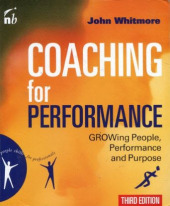Coaching for Performance – GROWing People, Performance and Purpose, Third edition: John Whitmore
 Whitmore says that the purpose of his book is:
Whitmore says that the purpose of his book is:
“describing and illustrating what coaching really is, what it can be used for, when and how much it can be used, who can use it well and who cannot.”
The book is designed to explain the principles of coaching in lay terms.
Useful gems
- Whitmore says that Gallwey (“The Inner Game”) put his finger on the essence of coaching, which Whitmore then paraphrases as: “… unlocking a person’s potential to maximize their own performance. It is helping them to learn rather than teaching them.”
- He suggests that the desired outcomes the coach should be helping the client to achieve are awareness and responsibility; and is emphatic that awareness and responsibility are the most important things to take away from this book
- There are some nice basic questions on page 52 to take a coaching conversation a bit further, and some more in the Appendix
- Whitmore then sets out GROW, which is probably the best-known mnemonic in coaching, spelling out Goal, Reality, Options and What/When/by Whom and Will as his preferred headings for a sequence of coaching questions to use to structure a coaching conversation.
Why I rate this book
- The GROW model and this book are so well-known, and so often quoted, that they are almost in the “must have read” category for any practising coach. The book is a recognised coaching primer and is clear, simple, and easy to understand
- The “does what is says on the tin” nature of GROW as a mnemonic is a masterstroke. I think that GROW is a really useful reminder for the inexperienced coach of the kind of things that he/she will want to cover in a coaching conversation. Where I part company from Whitmore (which is cheeky, I know, given that this is his model!) is that I have never found that GROW works well if you suggest to inexperienced coaches that it should be used as a sequence. In my experience, a coaching conversation may well snake back and forth between the four headings of GROW, and to try to channel that conversation into the GROW sequence harms both the development of that coaching conversation and its outcome. I much prefer to suggest to inexperienced coaches that they can use GROW lightly, moving through Goal, Reality, Options and Will in the way that seems most helpful to the client
- Whitmore rightly highlights the importance of the coaching client taking responsibility for his/her action and choices. However, he does nothing in this book to help the coach to support the client in getting there. The book touches on one model of motivation (that of Abraham Maslow); suggests that self-actualisation is what we all strive for; and then leaves the reader with neither the insight nor the tools to help clients to make progress towards this goal. Moreover, I don’t agree with Whitmore that it is the coach’s job to take notes and capture actions for the client – I think that this risks taking away responsibility from the coaching client
- Most of the coaching examples in the book are sporting ones and the example used to demonstrate GROW over a number of chapters is centred on fitness and weight loss. For me, this is a real limitation of the book. My psychotherapist colleagues tell me that weight loss is a potentially difficult area, and one that the inexperienced coach is best to steer away from. Given that, I think that Whitmore might have been better off either choosing another example, or adding much more on working with a client around finding the motivation for change and really wanting to take responsibility for making that change happen.
In GROW Whitmore gave the world of coaching a simple and well-used tool and he deserves enormous respect for that. However, this book does not add much to GROW as a tool. The book takes a very down-to-earth approach to coaching, and that is refreshing and welcome. It will probably be useful to people who are just getting involved in coaching, and it will give them comfort that coaching can be sensible, straightforward and practical. I doubt that the book will add much to the experienced coach.
 Visit Amazon for more reviews, and a competitive price: Coaching for Performance – GROWing People, Performance and Purpose, Third edition: John Whitmore
Visit Amazon for more reviews, and a competitive price: Coaching for Performance – GROWing People, Performance and Purpose, Third edition: John Whitmore
Paperback: 168 pages
Publisher: Nicholas Brealey Publishing; 3rd Revised edition edition (12 Mar 2002)
Language: English
ISBN-10: 1857883039
ISBN-13: 978-1857883039
Dimensions: 22.8 x 18.8 x 1.8 cm
 Share Article
Share Article